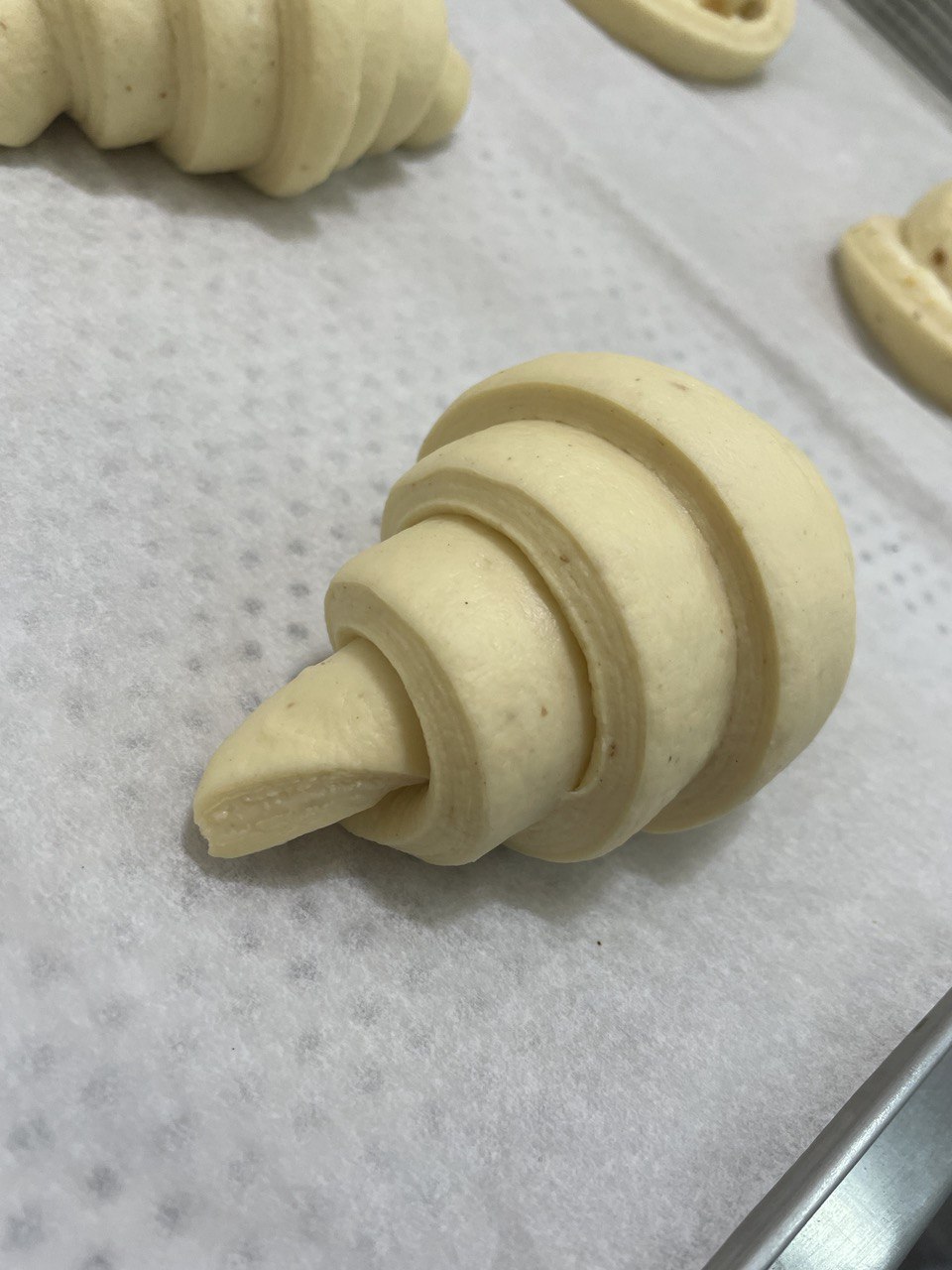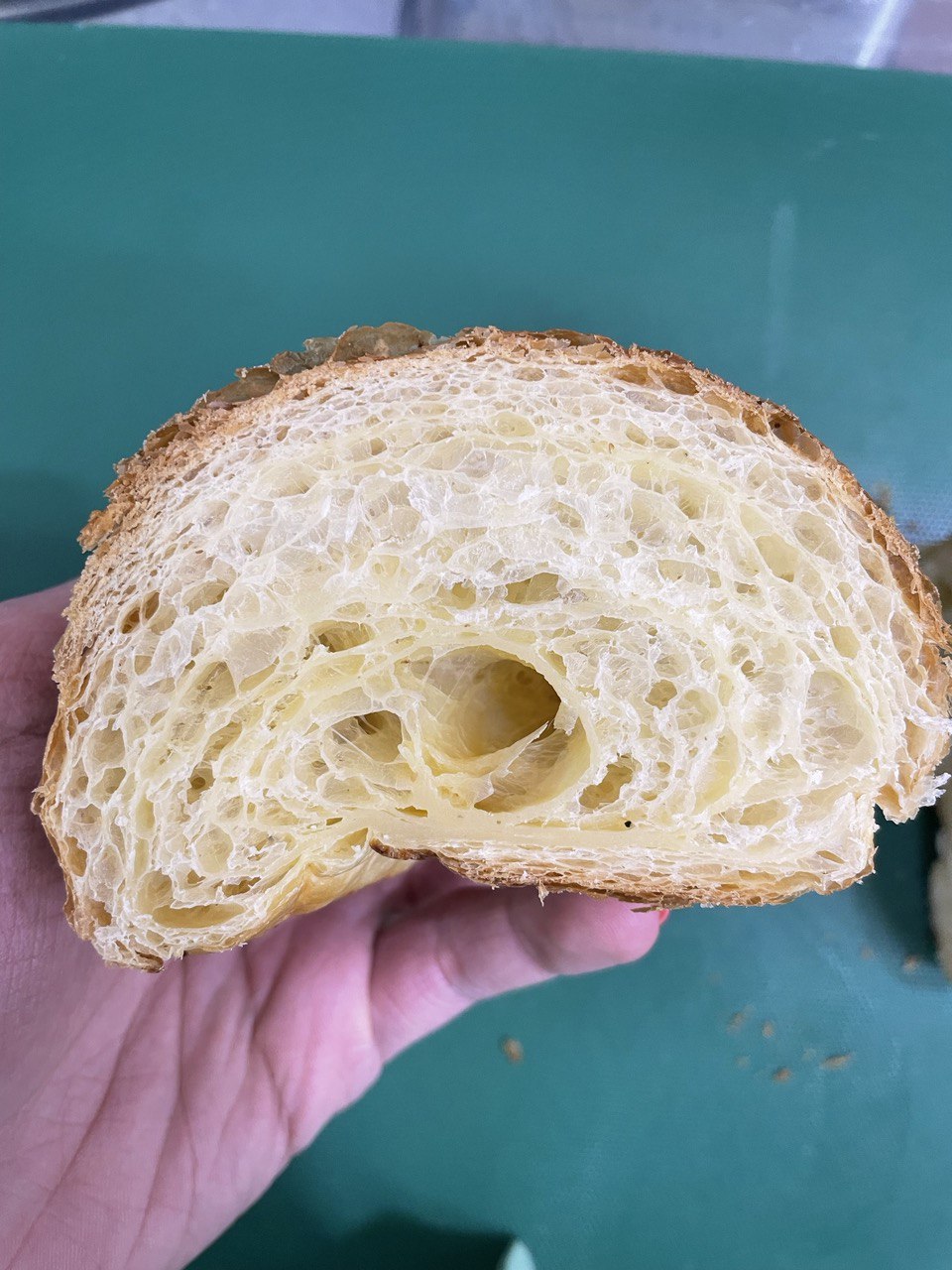
Hey folks!
I’ve been working on a croissant recipe for a few months, and I think that I’ve achieved an okay result so we could start selling those in our bakery, but I still feel that we’re not quite there yet.
I used a formula for poolish croissants from Michael Suas' Advanced Bread and Pastry as a basis, though I made some changes to this formula to make it suit specific ingredients and needs. The biggest change is that I've multiplied the amount of yeast by 1.5 since we're freezing some of our croissants right after shaping and additional yeast is advised.
Anyway, I bulk ferment this dough for 1 hour. After the dough is fully cooled, I do one double fold and two single folds, with 30 minutes of rest in the refrigerator after each fold. After the final rest, I roll out the dough to 5 mm thickness and 30-ish mm width (to further cut it down to exactly 30 mm). The base of each triangle is 10 cm, with a 2 cm cut in the middle of each base.
As I said, the result is okay, but there’s room for improvement. There are two parts of the recipe I’m struggling with the most.



1. The biggest issue I have is that some croissants collapse after baking, with visible separation of rolls. I usually proof and bake an entire batch, so it probably has nothing to do with either proofing or baking. Either way, there is always a significant number of croissants (though not all of them) which collapse after taking them out of the oven. Those usually (again, not always) start to show some separation during proofing. I've really run out of reasons why it ends up this way. I've experimented with different approaches to shaping (rolling tighter, brushing triangles with water before shaping for better sticking) and it seems not to be the reason after all.
2. I proof these for about 3 hours at about 27C and 80% humidity. It's longer than most recipes I've read and seems even more weird considering an increased amount of yeast. What mistake could lead to this?
Do you have any advice on how to troubleshoot these issues? Any other feedback or comments will be appreciated.
Your pre-bake and exterior post-bake look awfully nice. But the crumb you show seems to have lost definition of the layers which could possibly be caused by letting your butter layers get too warm. Do you refrigerate your butter slab after prepping it to size? After creating my slab I’d always give a 30-60 minute cool off in the fridge. Could maybe be accelerated in freezer. In addition I generally give 1-2 hour rests between folds, significantly longer than you. What’s your butter to dough ratio? For 1 kg of dough I would use ~333 g of butter.
I’m a bit more conservative with my proof temp (24) and duration is 1.5-2 hours. At 2 hours I tend to have more trouble with the dough wanting to stick to the tea towels I cover them with. That extra hour at warmer temperature could well be your fundamental problem.
I haven’t had great or consistent results from frozen shaped rolls. Fully baked croissants seem to work better for me though you have to be careful not to over bake them when rewarming. Occasionally I’ll make dough for 2-3 dozen, store it in the fridge and shape, proof, bake several mornings in a row. Have never held dough for more than 4 days but suspect it’s possible.
Don’t’ give up. You’re obviously doing something right. Just need to tune…
Bonne chance,
Phil
My butter and dough are thoroughly refrigerated throughout the process. Moreover, I work in rather cold conditions when laminating, so I don't feel like my butter layers melting is a problem. I use an amount of butter that is 25% of détrempe weight (so 562 g of butter for 2.25 kg of dough), which is what the book with the original formula advises to do.
Proofing-wise, I'll definitely experiment more with that. I tried do adjust my proofing times by starting at 1.5 hours and adding 10 to 15 minutes with every batch. Since proofing time and temperature are the part of the recipe I doubt the most, I'm going to do more testing and will follow up with results in the next few days.
Regarding pre-baked frozen croissants, can you provide me with some explanation of how you warm them up? I've tried multiple times, but they always end up being significantly worse than fresh ones, especially a couple of hours after reheating them.
I just take them out of the freezer and place them in a 170-190 C oven. 12-15 minutes or until internal temp is at least 80-85 C. Not quite as great as fresh but a lot quicker.
If you have collapsing loaves (whether bread, enriched dough etc), I think the first thing to ask is whether you've over-proofed. You already got one hit saying that 3 hours is really long. I don't think there's much wrong with the folding schedule but proofing 3 hours seems long and the pics seem to indicate that the same. Other than that, the pic you have shows a pretty nice looking croissant. It looks like the kind I see in doughnut shops. Large and fluffy. If you are going for more boulangerie style it does seem like cutting back on proofing is a good next idea :)